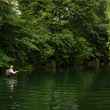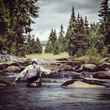There was no denying it the day was going downhill. I was fishing the Wairau River, a pristine wilderness stream that rose in the evergreen-blanketed Saint Arnaud Range on New Zealand’s South Island, then wound and snaked its way through narrow gorges and valleys for 150 kilometres before reaching the Pacific. It was a gorgeous late-summer day, with temperatures in the 70s, not a cloud in the sky. I was standing in water so clean and pure you could drink it; 20 yards ahead, water was cascading through as pretty a riffle as you’d ever want to see, flowing into a deep, azure-blue turn pool. Such pools, as I’d discovered in the past few hours, often held at least one trophy brown trout, fish that averaged 4 pounds and went up to 8 or 9.
Behind me, my guide, Paul van da Loo, wiped a grimace off his face, and remarked, “Well, let’s hike up to the next pool. That fish you just missed isn’t coming back.”
And so it had gone that morning. In the first two pools, I had struck too slowly when my dry fly strike indicator suddenly disappeared beneath the water, the trout below spitting out my No. 18 gray nymph well before my reaction. Then, at the next pool, I piled up my 18-foot leader right on top of a trout sitting behind a midstream boulder, sending him fleeing from the pool as if the Forces of Darkness were attacking. Later, I lined another fish. When I finally did hook one, a monster that had to go at least 7 pounds, his downstream run out of the pool was so powerful that I broke him off in seconds.
The fish that had Paul wincing had also been a good one. I had made a poor cast, five feet to the right of the trout’s position. Frustrated, I yanked my fly out of the water, planning to make another, better-positioned cast. That, of course, is when the fish decided he wanted to eat my cricket imitation, and made a rush for it. The image of his open mouth, right behind the fly as I deftly pulled it away from him, is one that’s going to haunt me for a long time. What really bugged me is that I know better.
Reeling in line, I clambered over more rocks and boulders, moving up to the next pool. I wondered how I would manage to screw up on the next fish. I was befuddled, frustrated, questioning my abilities. Here I was in fly-fishing paradise, a promised land that every trout angler worth his Wheatleys wants to fish. Who hasn’t seen the photos of all those monster rainbows and browns, the uncrowded, pristine streams, the smiling faces of anglers holding up trophy after trophy. To date, all I had to show for my efforts of coming all the way to New Zealand from New York – 5 hours from JFK to LAX on American Airlines, then 12 hours from LAX to Auckland on Air New Zealand, then 1 hour to Nelson, on the South Island, with various layovers along the way – were some photos of some “small” – 3 – to 4-pound browns – that I had taken from the Motueka River the day before. Clearly, these big fish were rattling me. I had to pull myself together.
Planning a Dream
The idea of going to New Zealand wasn’t new to me. Even back in college, posters of white sand beaches, misty waterfalls in lush tropical settings, and green ridgetops marching across the land like soldiers used to adorn the walls of my dorm room. Hell, I’d been trying to figure out how to put together a trip for years. Then, last fall, I called New Zealand Tourism and asked for brochures and other information about fishing there. Turns out it wasn’t all that outrageously expensive to go there. Flights from L.A. to Auckland went for less than $800 round-trip in coach, with Air New Zealand occasionally giving even lower-priced deals. The wheels in the piscatorial part of my brain started turning.
My plan was to fish both the North and South islands, to get a sample of what the country had to offer. I’d fish for browns on the Motueka River on the South Island for a day and a half, do a day of helicopter fishing for browns in the backcountry, then fly to the North Island and hit sprawling Lake Taupo for rainbows one morning, fly fish a river in the Taupo area a second day, do a day of heli fishing on the central plateau on my last day, then head home. It was a grueling schedule, with overnights at a number of lodges and bed and breakfasts, but this was the finest place in the world to fish, an opportunity I might not get again. I’d fish every moment I could, then sleep on the plane home.

Before my trip, I assembled my gear with care, taking only what I knew I would use: a Scott S4 Weight 6 flyrod, 9 feet, paired with a large-arbor Nautilus reel loaded with 20 yards of backing, Rio’s new Trout flyline in weight-forward Weight 6; plus an LL Bean four-piece 7-weight rod and matching large-arbor fly reel, loaded with 20 yards of backing and LL Bean flyline, in weight-forward Weight 7. Both carried hand-made, knotted 18-foot 5X leaders, the extra length designed to give me an edge on ultra-wary fish in clear water.
I left my waders at home. The invasive algae, Didymo, is a huge problem on the South Island, and most lodges prefer that guests use house waders with rubber- soled boots (felt soles are banned nationwide). Boots are washed in a soapy bath with fungicide at the end of each day.
Astream
All this was well and good, but here I was on my second day of fishing, and my “A” game was still back in the States.
After a stream-side lunch, Paul and I headed farther upstream. Over sandwiches, Paul had gently suggested that I was perhaps hurrying things a bit, not letting the unfamiliar 18-foot leader unfurl completely, and that, in my frustration, I was underpowering my forward casts. He was right. I had to get back into my groove, pretend I was back on the Beaverkill or the Neversink, make believe I was casting to 15-inch browns, not 28-inch ones.

Hiking over a kilometer’s (1.609 kilometers = 1 mile) worth of rocky shore paralleling shallow, featureless runs, we came upon a huge, deep, 40-yard-long pool. Near the head, behind an underwater boulder, we could both see a large fish silhouette on the bottom.
“He’s moving back and forth,” Paul observed. “He’s feeding, which is good. Gives us a better chance.
“He’s a good one.”
Wading into the bottom of the pool, I inched forward, taking care not to roll any rocks or make a wake as I moved. Thirty feet below the fish, I stopped, pulled at least that much line off my reel, made two false casts, and dropped my No. 18 Adams 10 feet in front of the boulder. Stripping in slack, I watched as the fly floated drift-free right over the fish. The shadow rose ghost-like to the surface, and then a huge maw came out of the water and inhaled my offering. Rearing back, I felt resistance as the hook pierced the fish’s mouth. Within seconds, the trout was boring upstream, trying to get into the fast water. I heard Paul whooping in the background, telling me to keep the rod tip high (I was). The fish turned and ran downstream, but I applied side pressure with the rod and stopped him from getting out of the pool. Then it turned into a dogfight, with the big brown burrowing to the bottom, and with me applying varying degrees of pressure, keeping him moving, fighting, wearing him down.
And then it was over. I guided him to shore by slowly walking backwards, and gently guided him into Paul’s waiting net.

“Welcome to New Zealand, “ said Paul as he smiled and offered me a handshake. We taped the fish at almost 30 inches, while the scale in the net read 7 1/4 pounds, my biggest stream brown trout ever. I held that fish carefully in the water, admiring his girth, letting him regain his strength, then in a splash he finned his way out of my grasp. As I thanked him quietly, I could hear the wopwop of a helicopter approaching. On what turned out to be the last pool of the day, I had finally gotten my game on. I couldn’t wait for tomorrow.































Comments